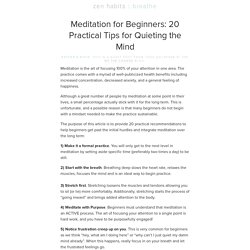

Transcendental Meditation technique. The Transcendental Meditation technique is a specific form of mantra meditation[1] developed by Maharishi Mahesh Yogi. It is often referred to as Transcendental Meditation, or simply TM. The meditation practice involves the use of a mantra and is practiced for 15–20 minutes twice per day while sitting with one's eyes closed.[2][3] It is reported to be one of the most-widely practiced,[4][5][6] and among the most widely researched meditation techniques,[7] with over 340 peer-reviewed studies published.[8][9] Beginning in 1965, the Transcendental Meditation technique has been incorporated into selected schools, universities, corporations, and prison programs in the U.S.A., Latin America, Europe, and India. Practice[edit] Mantra[edit] Selection[edit] The Maharishi is reported to have standardized and "mechanized" the mantra selection process by using a specific set of mantras and making the selection process "foolproof".[19][33] Professor of psychiatry, Norman E.
Course descriptions[edit] Sahaja Meditation. Meditation for Beginners: 20 Practical Tips for Quieting the Mind. Editor’s note: This is a guest post from Todd Goldfarb at the We The Change blog.

Meditation is the art of focusing 100% of your attention in one area. The practice comes with a myriad of well-publicized health benefits including increased concentration, decreased anxiety, and a general feeling of happiness. Although a great number of people try meditation at some point in their lives, a small percentage actually stick with it for the long-term. This is unfortunate, and a possible reason is that many beginners do not begin with a mindset needed to make the practice sustainable. The purpose of this article is to provide 20 practical recommendations to help beginners get past the initial hurdles and integrate meditation over the long term: 1) Make it a formal practice. 2) Start with the breath. 4) Meditate with Purpose. 5) Notice frustration creep up on you. 6) Experiment. 7) Feel your body parts. 8) Pick a specific room in your home to meditate.
The Transcendental Meditation® Technique – Official Website. How and Where to Learn.
How to Meditate. Note: These instructions are drawn from the vipassana traditions of Mahasi Sayadaw and Chao Khun Bhavanapirama Thera.

It is assumed the reader is familiar with the article, What is Vipassana? Contents This article offers step-by-step instructions for nine insight meditation exercises, as well as a detailed explanation of mindful eating, hints on dealing with problems such as wandering mind, sleepiness, disturbing mental images, unpleasant emotions, and more. The following exercises are not necessarily listed in order of difficulty. Exercises suitable for beginners are noted. To start, choose one or two exercises and practice them daily. If there's something you don't understand at first, please don't let that daunt you. Although these Buddhist meditation exercises come from the traditions of the Burmese teacher Mahasi Sayadaw and the Thai teacher Chao Khun Bhavanapirama Thera, you don't have to be a Buddhist to practice them. A Suitable Place Clothing Sitting Styles Resolution(Optional) Pain. Transforming Meditations. Meditation is a method for acquainting our mind with virtue.

The more familiar our mind is with virtue, the calmer and more peaceful it becomes. When our mind is peaceful we are free from worries and mental discomfort, and we experience true happiness. If we train our mind to become peaceful we shall be happy all the time, even in the most adverse conditions, but if our mind is not peaceful, then even if we have the most pleasant external conditions we shall not be happy.
Therefore it is important to train our mind through meditation. When our mind is peaceful we are free from worries and mental discomfort, and we experience true happiness. There are two types of meditation: analytical meditation and placement meditation. Since most of the problems we experience when we are new to meditation come from overstraining at placement meditation, it is important to be moderate and avoid becoming tense from exerting too much pressure. How to Meditate - Guided Meditation Techniques - Buddhist Meditations.